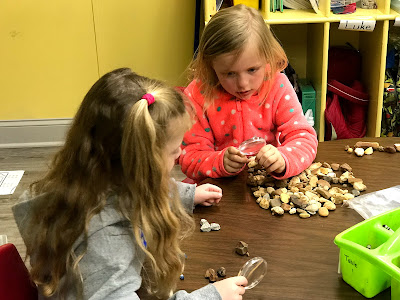We noted the colors, shapes, gradiations, etc., found within the various rocks. Some of them were very different!
Our next step was to sort the rocks. I deliberately didn't give them specific instructions on exactly HOW to sort them--I wanted to see what they'd come up with. Most sorted their rocks according to size, but some divided them into groups based on color, shape, or other feature. Later, we talked about how scientists have to decide what criteria they will use when they classify items. (Italics for the fancy science words we are already learning.)
Each day we learned about a different kind of rock--igneous, metamorphic, and sedimentary. Because a big quality of each of these different rocks is how they are created, I thought it would be fun to do a hands-on activity.
Igneous rocks are made by the extreme heat in the earth's core. Sedimentary rocks are made by various layers being compressed over time. To demonstrate this, we took the same three items -- graham cracker pieces, M&M's, and marshmallows -- and carefully crushed them together. (Yes, we did eat them when we were finished!) The finished product was loosely similar to a sedimentary rock. Next, we took more crackers, M&M's, and marshmallows ... but instead of crushing them, we heated them up in the microwave! The heat melted the marshmallows, which sort of glued everything else together. The resulting "igneous rock" looked very different than our sedimentary rock.
This was the perfect way to see firsthand how heat and pressure can create different changes in the same combination of items. Science is interesting, fun, and delicious!
















